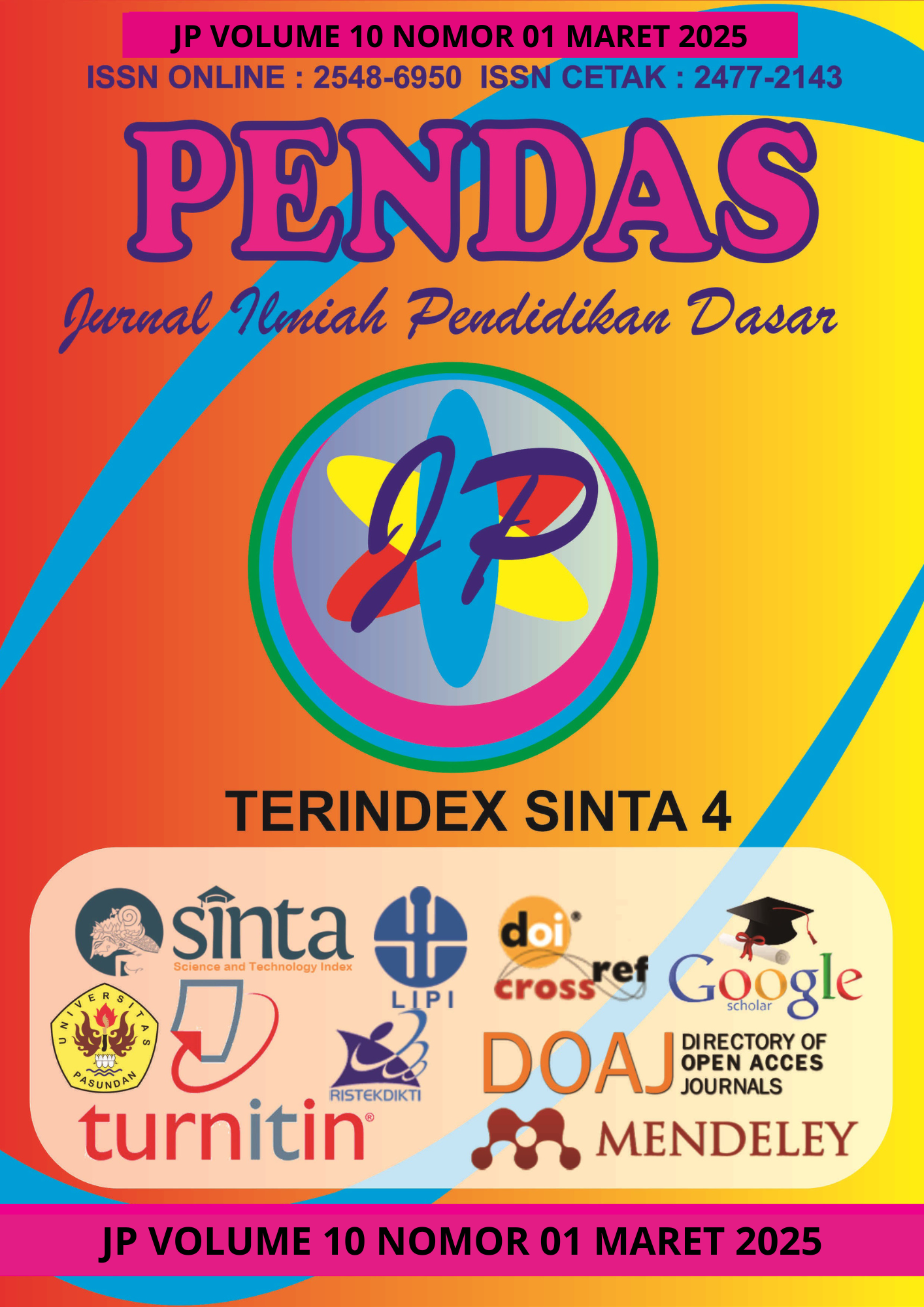PENGARUH MEDIA PEMBELAJARAN INTERAKTIF BERBASIS APLIKASI CANVA TERHADAP HASIL BELAJAR SISWA KELAS V MATA PELAJARAN IPAS MATERI KENAMPAKAN ALAM DI SDN PABIAN IV
DOI:
https://doi.org/10.23969/jp.v10i01.21932Keywords:
Interactive Media, Canva Application, Learning Outcomes.Abstract
This research is motivated by the low learning outcomes of students on natural appearance materials, which is caused by the lack of use of interactive learning media that is relevant to student needs. This study aims to analyze the influence of Canva application-based interactive learning media on the learning outcomes of grade V students at SDN Pabian IV. The method used is quantitative using one group pretest-posttest design. The research sample consisted of 21 students in class V who were selected purposively. Data was obtained through learning outcome tests before (pre-test) and after (post-test) the use of Canva learning media. Data analysis includes normality tests and paired t-tests to determine the distribution of data and the significance of differences in learning outcomes. The results showed that the average pre-test score was 69.52 with a minimum score of 30 and a maximum of 100, while the average post-test score increased to 77.62 with a minimum score of 50 and a maximum of 100. The normality test showed that the pre-test and post-test data were normally distributed, with significance values of 0.298 and 0.118 (p > 0.05), respectively. The t-test produced a significance value of 0.000 (p < 0.05), which indicates a significant improvement in learning outcomes after the use of Canva media. This study concludes that interactive learning media based on the Canva application is effective in improving student learning outcomes on natural appearance materials. The use of this media can be an innovative alternative for learning that is more interesting and relevant to technological developments.
Downloads
References
Abd Rahman BP, S. A. M. A. F. Y. K. Y. (2022). PENGERTIAN PENDIDIKAN, ILMU PENDIDIKAN DAN UNSUR-UNSUR PENDIDIKAN. Al Urwatul Wutsqa: Kajian Pendidikan Islam, 2(1), 1–8. https://journal.unismuh.ac.id/index.php/alurwatul
Akbar, A., & Noviani, D. N. (2019). TANTANGAN DAN SOLUSI DALAM PERKEMBANGAN TEKNOLOGI PENDIDIKAN DI INDONESIA. file:///C:/Users/hp/Downloads/admin,+Amin+Akbar+dan+Nia+Noviani (1).pdf
Amaliya, F., AR, M. M., & Astuti, Y. P. (2024). The influence of the application of the snowball-throwing model based on local wisdom on the critical reasoning ability of elementary school students. Electronic Journal of Education, Social Economics and Technology, 5(2).
Asmoni, A., & Kuswandi, I. (2021). College Survive Strategy Through Risk Management. Praniti Wiranegara (Journal on Research Innovation and Development in Higher Education), 1(1), 01-09.
Aulia, D., F., & Desyandri. (2023). PENGARUH MULTIMEDIA INTERAKTIF BERBASIS CANVA TERHADAP KEMAMPUAN MEMBACA PERMULAAN SISWA SEKOLAH DASAR. In ALPEN: Jurnal Pendidikan Dasar, 7(1).
BK, M. K. U., Barsihanor, Rudini, M., Jamilah, Jasiah, Mariamah, Meidawati, Suswandari, Cendana, W., Setiawan, A., Wibowo, T., Purwandari, E., & Hamna. (2020). METODE PENELITIAN UNTUK PGSD/PGMI (A. Setiawan, Ed.). Nuta Media, Yogyakarta.
Dyaning Wijayanti, I., & Ekantini, A. (2023). Pendas: Jurnal Ilmiah Pendidikan Dasar. Pendas: Jurnal Ilmiah Pendidikan Dasar, 08(02), 2100–2112.
Eko Yulianto, D., & Ferawati, V. (2023). PERBEDAAN HASIL BELAJAR MENGGUNAKAN MEDIA VIDEO DENGAN MEDIA GAMBAR MATA PELAJARAN IPAS PADA KURIKULUM MERDEKA MATERI KENAMPAKAN ALAM KELAS IV SDN 1 BESUKI 2 KABUPATEN SITUBONDO TAHUN 2023 PGSD, FKIP Universitas Abdurachman Saleh Situbondo. 14(2).
Fauziah, Z., Shofiyuddin, A., & Rofiana, H. (2022). Implementasi Media Pembelajaran Interaktif Berbasis Aplikasi Canva Pada Mata Pelajaran Sejarah Kebudayaan Islam. Madinah: Jurnal Studi Islam, 9(1), 7–18. https://doi.org/10.58518/madinah.v9i1.1356
Hajar, O., Kasiyun, & S., Umar Susanto, R. (2023). Pengaruh Media Pembelajaran Berbasis Aplikasi Canva Terhadap Minat Belajar Siswa Kelas V di Sekolah Dasar. ,. Journal on Education, 6(1), 6404–6413.
Kuswandi, I., Asmoni, Fauzi, M., & AR, M. M. (2024). Pelatihan Karya Tulis Ilmiah melalui Kegiatan “Workshop Riset” bagi Siswa di Kabupaten Sumenep. Jurnal Publikasi Pendidikan, 14(3), 318–326.
Nabillah, T., & Abadi, A. P. (2019). Prosiding Seminar Nasional Matematika dan Pendidikan Matematika Sesiomadika.
Nasution, M. D., Irvan, & Ramadhan, R. (2023). Pengaruh Model Pembelajaran Problem Solving Terhadap Kemampuan Pemecahan Masalah Siswa Kelas VIII SMPIT Miftahul Jannah. ,. Journal Of Social Science Research, 4(3), 260–268. https://j-innovative.org/index.php/Innovative
Nuryanti, R. (2019). PENGGUNAAN MODEL PEMBELAJARAN KOOPERATIF DENGAN STRATEGI TEAM GAMES TOURNAMENT (TGT) UNTUK MENINGKATKAN HASIL BELAJAR MATEMATIKA PADA MATERI BILANGAN ROMAWI BAGI SISWA TUNARUNGU KELAS IV SDLB.,. JASSI_anakku, 20(1), 40–51.
Oktavia, V. N., AR, M. M., & Armadi, A. (2024). Inovasi Bahan Ajar Flipbook Berbasis PUBLUU dalam Mendukung Kemandirian Belajar Siswa pada Sekolah Dasar. JURNAL BASICEDU Research & Learning in Elementary Education, 8(6), 4742–4750. https://jbasic.org/index.php/basicedu
Sugiyono. (2020). METODE PENELITIAN KUANTITATIF, KUALITATIF DAN KOMBINASI (MIXED METHODS)) (Sutopo, Ed.; 2nd ed.). ALFABETA.
Downloads
Published
Issue
Section
License
Copyright (c) 2025 Pendas : Jurnal Ilmiah Pendidikan Dasar

This work is licensed under a Creative Commons Attribution 4.0 International License.



















